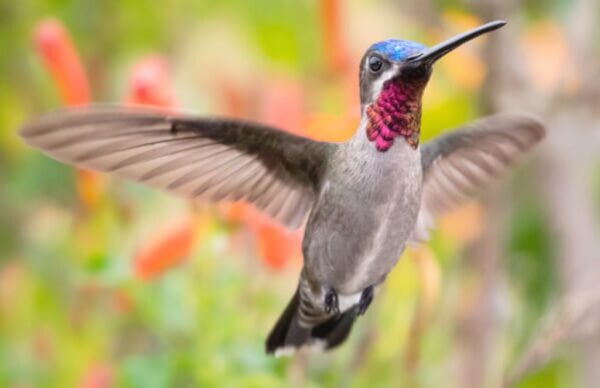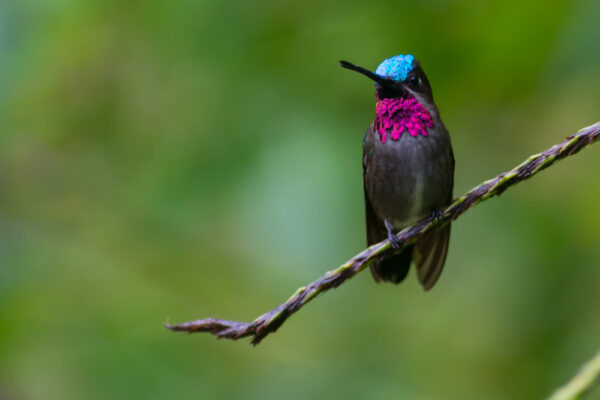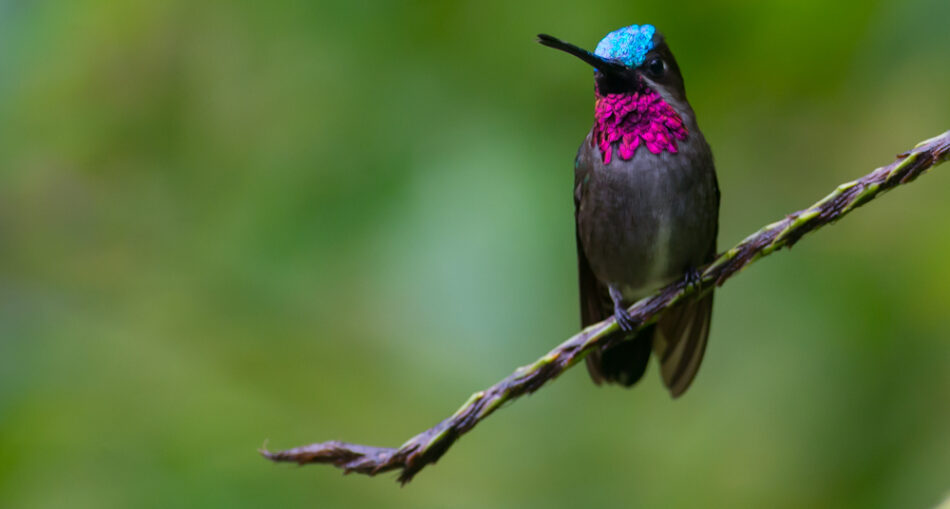The Long-billed Starthroat (Heliomaster longirostris) is a remarkable hummingbird species that has captured the attention of ornithologists and birdwatchers alike.

The Long-billed Starthroat [Photo: American Bird Conservancy]
TAXONOMY AND SYSTEMATICS
Originally classified under the genus Anthoscenus, the Long-billed Starthroat was placed in the genus Heliomaster in the mid-20th century.
This species is part of the Lampornithini tribe, known as the ‘mountain gems’ within the subfamily Trochilidae. The Long-billed Starthroat consists of three recognised subspecies:
- l. longirostris: The nominate subspecies, found in a wide range across Central and South America.
- l. pallidicepts: Located primarily in southern Mexico and parts of Central America.
- l. abscissa: This subspecies is restricted to western Ecuador and northwestern Peru.
In Guyana, the most commonly observed subspecies is H. l. longirostris, renowned for its stunning plumage and unique characteristics.
DESCRIPTION
The Long-billed Starthroat is relatively large for a hummingbird, measuring between 11 to 12 cm (4.3 to 4.7 inches) in length. Males typically weigh between 5.5 to 7.1 g (0.19 to 0.25 oz), while females are slightly heavier at around 6.5 g (0.23 oz).
One of its most distinguishing features is its long, straight black bill, accompanied by a small white spot behind each eye.

The Long-billed Starthroat (Heliomaster longirostris) [Photo: Joao Quental – Flickr]
The black face is complemented by a white malar stripe, while the gorget displays a rich, dark metallic purple hue.
Conversely, females exhibit less vibrant colours, with a much-reduced blue crown and a narrower, dusky grey gorget.
DISTRIBUTION AND HABITAT
The Long-billed Starthroat can be found throughout Central and South America, with its habitat extending from southern Mexico, through Central America, and down to parts of Bolivia and Brazil.
In Guyana, this beautiful hummingbird inhabits a variety of humid semi-open landscapes. These include the edges of woodlands, isolated trees, pastures with scattered trees, gallery forests, and secondary forests.
Preferring lowland and foothill regions, the Long-billed Starthroat can typically be found at elevations ranging from sea level up to about 1,500 m (4,900 ft).
The bird is known to shy away from the interior of closed forests, favouring areas that allow easy access to flowering plants.
BEHAVIOUR
MOVEMENT
The Long-billed Starthroat’s movements are somewhat erratic and not entirely understood. These birds tend to respond to the flowering patterns of different plant communities, which influences their foraging behaviour and territorial range.
FEEDING
As a nectar feeder, the Long-billed Starthroat primarily consumes nectar from flowers, particularly favouring large trees, vines, shrubs, and Heliconia.
The hummingbird employs a foraging technique known as ‘trap-lining,’ visiting a circuit of flowering plants regularly.
It also has a unique ability to defend flower-laden trees, ensuring access to ample food resources. Additionally, this species is an adept insect hunter. It captures small insects in mid-air and gleans from vegetation.
VOCALISATION
The Long-billed Starthroat’s calls are characterised by a rich liquid ‘tseep’ or ‘tsew,’ along with squeaky twitters made during chases. These vocalisations play an essential role in communication, especially during mating and territorial disputes.
BREEDING
Breeding typically occurs from the late wet season into the early dry season.
In Central America, this spans from October to March, while in northern Colombia, nesting can be observed as early as September.
The female Long-billed Starthroat constructs a shallow cup-shaped nest made of plant down, moss, and liverworts, held together with spider silk and covered with lichen.
Nests are typically placed between 4.5 and 12 m (15 and 39 ft) above the ground in shrubs, on exposed branches, or even on telephone wires.
After laying two white eggs, the female incubates them for 18 to 19 days. Once hatched, the chicks are blind and featherless, relying solely on the female for sustenance. The fledging process occurs approximately 25 to 26 days post-hatching.
Article References
- https://en.wikipedia.org/wiki/Long-billed_starthroat
- https://abcbirds.org/bird/long-billed-starthroat/
- https://ebird.org/species/lobsta1







